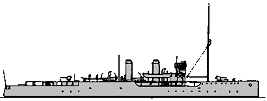
MALLOW sloop (1915/1919)

Mallow 1919
| Name | No | Yard No | Builder | Laid down | Launched | Comp | Fate |
| Mallow | T59 | Barclay Curle, Glasgow, UK | 1915 | 13.7.1915 | 8/1915 // 7.1919 | dismantled 7.1932 |
|
Displacement normal, t |
1200 |
|
Displacement full, t |
1275 |
|
Length, m |
76.2 pp 80.0 oa |
|
Breadth, m |
10.1 |
|
Draught, m |
3.36 |
|
No of shafts |
1 |
|
Machinery |
1 VTE, 2 cylindrical boilers |
|
Power, h. p. |
1800 |
|
Max speed, kts |
16.5 |
|
Fuel, t |
coal 130 |
|
Endurance, nm(kts) |
2000(15) |
|
Armament |
2 x 1 - 76/40 12pdr 12cwt QF Mk I/II, 2 x 1 - 47/40 3pdr Hotchkiss Mk I, 2 DCT, 1 DCR, mechanical minesweeping gear |
|
Complement |
90 |
Project history: Soon after the outbreak of war in August 1914 the Admiralty realised the need for additional vessels capable of minesweeping, for general service, towing and the transport of libertymen and stores. The DNC produced a design based on mercantile scantlings, simple and robust, and capable of being built by non-specialist yards. By standardising on fittings building rates were accelerated and several were built in 19-21 weeks. Being single-screw ships they had large turning circles, and they carried steadying sail to assist in keeping their head to wind. To protect the ammunition it was carried in a lightly armoured 'box' magazine far aft; on several occasions the entire magazine was blown into the air by a mine-explosion without detonating the contents. Later vessels were fitted with treble-thickness plating around the bows and reinforced bulkheads forward. The first 12 ships were ordered on 1 January 1915, followed by another 12 on the 12th. They were delivered between May and September 1915. They were almost exclusively used on minesweeping until 1917, when they proved ideal for convoy escort.
Modernizations: None.
Naval service: No significant events.
© Ivan Gogin, 2015